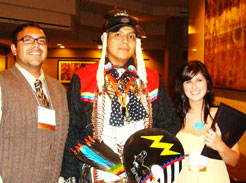
Sophomore Sasha Indarte’s flair for statistics research took her to Texas, Mexico, then California, where she presented her prize-winning research at the Society for Advancement of Chicanos and Native Americans in Science conference.
Sasha Indarte ’13
Minneapolis, Minnesota
Applied Mathematics and Statistics and Economics
Math Department | Economics Department
Other interests: Macalester Investment Group, Women in Economics, and Women in Science and Math. In my free time I love to play piano and guitar, do yoga, bake and read.
 Research program: I attended the Rice University Summer Institute of Statistics, part of Research Experiences for Undergraduates (REU), supported by the National Science Foundation and the National Security Agency. The application process is highly competitive (there was approximately a 9% acceptance rate), but I was accepted after my first year at Mac.
Research program: I attended the Rice University Summer Institute of Statistics, part of Research Experiences for Undergraduates (REU), supported by the National Science Foundation and the National Security Agency. The application process is highly competitive (there was approximately a 9% acceptance rate), but I was accepted after my first year at Mac.
Research site: Rice University, Houston, Texas
Research focus: For 10 weeks I worked with Dr. Javier Rojo of the Statistics Department and 16 other students from around the country. Dr. Rojo and two graduate students taught us courses on computation, probability, statistical inference, stochastic processes, extreme value theory, and survival analysis. In our third week, we travelled to Guanajuato, Mexico, for the Pan-American Advanced Studies Institute (PASI), where we attended lectures on finance and statistics given by professors from all over the world.
Research groups: After Mexico, we formed small research groups. I worked with three other students developing and testing new estimation methods for survival data with partial censoring under peakedness order constraints. Survival functions model the time until a specified event occurs for a population. For example, you may have data on people who had stage 1, 2, 3 or 4 lung cancer, who are in remission. Survival analysis helps you make predictive models about how long one can expect to stay in remission. “Censored data” refers to incomplete data, for example, when patients drop out of a study over time. We ended up improving upon an estimation method Dr. Rojo developed several years ago, then wrote a paper and created a PowerPoint to discuss our research.
Results: This fall I attended the Society for Advancement of Chicanos and Native Americans in Science (SACNAS) conference in Ahaheim, California. With two others of my summer research group, I won a travel scholarship to attend this event and present our research. At the event I won an award for the presentation of my research and a $500 cash prize.
Future plans: I intend to pursue a PhD in either statistics or economics. I really enjoy school and learning and hope to be involved in academics for a very long time.
November 4 2010
Back to top




